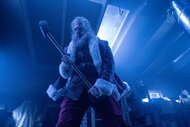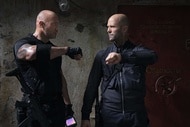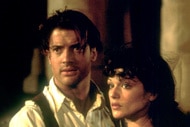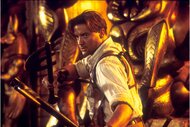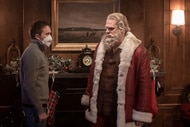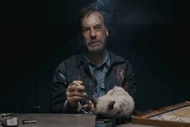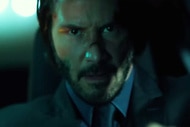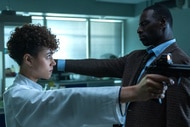Create a free profile to get unlimited access to exclusive videos, sweepstakes, and more!
There's no room for Siri or Alexa in The Umbrella Academy, Chilling Adventures of Sabrina and Maniac

A date that gets interrupted by a phone call is a pretty popular pop-culture trope, one you can see in countless movies and TV shows. However, it is uncommon for the ringtone to come from a person’s shoe. In 1965, the first episode of Get Smart introduced hapless spy Maxwell Smart (Don Adams) and his portable communication device. Gadgets hidden in everyday objects is a go-to espionage trick, from James Bond to real-life agents, but there is often a lot of truth in fiction.
The shoe phone did not take off, but the size and capabilities of computers from 1965 when viewed next to contemporary smartphones is a leap worthy of science fiction. Even technology from 20 years ago feels like a relic from many centuries ago. With each technological leap, a writer must consider how it will impact the action if a narrative is set in the present day; this is an era when a large number of the population will either own or have access to a cell phone or computer.
Watching the complete series of The X-Files is something I would recommend (well, mostly) for a number of reasons. If you are interested in how technology has evolved since its debut in 1993, then you are in for a treat. Computers and cell phones become more sophisticated and integral as it progresses — they even did an episode last season dedicated to technology becoming too powerful. It isn't surprising to see X-Files do a "Monster of the Week," in which the monster is modernity.A phone call or text message can impact the narrative, whether it is warning someone of dangers untold or sharing a vital piece of information that changes the entire story. Sure, there are ways to avoid the cell-phone savior, whether it is through the phone being on silent, there being no cell service, or the battery having died mid-action. This obstacle is probably most significant to horror, which is why in the new Halloween, Allyson’s (Andi Matichak) phone ends up in a big bowl of dip.
The Umbrella Academy, Chilling Adventures of Sabrina, and Maniac are all set in either the present day or a non-specific era featuring technology far beyond our current capabilities, but recognizable items are absent. The production design aesthetic for each show has a timeless quality, which mixes and matches from different decades, as well as an aversion toward certain everyday tech objects.
In Chilling Adventures of Sabrina, the town of Greendale is stuck in a 1960s time warp — the original comic book was set in this decade. Night of the Living Dead plays at the local theater, the decor and the diners all bear the hallmarks of a mid-20th-century glow (when it was easier to ignore or pretend that society wasn't incredible flawed). Witches and warlocks don’t age in the same way as humans, so a town that is home to these beings is likely to have certain quirks. It also isn’t unusual for teenagers to wear vintage clothing or listen to bands who are no longer alive, but Baxter High in Greendale is more Rydell High than Sunnydale in terms of how the kids behave.Hours spent talking on the phone is peak adolescence, something Sabrina (Kiernan Shipka) and Harvey (Ross Lynch) partake in, usually from landline to landline, but this is not really the 1960s. The latter is underscored when Sabrina rings Harvey on his iPhone X. Her cousin Ambrose (Chance Perdomo) also has a laptop. So we know that this is not a screen-free environment, despite first impressions created by the retro aesthetic. If you were beginning to wonder just when Sabrina is set, the flash of an Apple product quickly answers that question. I would argue it is unnecessary and distracting to go from this quasi-'60s setting and throw in something from 2018. Siri is obsolete in a world with powerful magic.
The title card for the first episode of Sabrina reads “Tuesday, October 28th of this Year,” with no specific year given (to fall down the calendar rabbit hole, the last time this date fell on a Tuesday was 2014; the next will be 2025). The Umbrella Academy is more specific, revealing the Hargreeves children were born October 1, 1989. Cut to the present day, which is also our present day, and while the world itself is recognizable, some of the tech is archaic while other aspects are light-years ahead. Cell phones don’t exist, which means a payphone is no longer an artifact from the past.Google and computers are replaced with a trip to the local library to use the microfiche reader, a moment that feels like the characters just stepped into a Stephen King novel (beware the clown). This is a world with talking chimpanzees, robot mothers, and a time-travel briefcase, but not an iPhone or social media. The advanced tech is littered with '50s visuals from the family's Artificial Intelligence — modeled on Grace Kelly and June Cleaver — to the time-travel headquarters location, which further adds to the off-kilter retro quality. There is also the notion that this was a simpler time before computers corrupted society, but that is ignoring the A-bomb, as well prevalent racism and sexism (of course a lot of this still exists now).
A best-of-both approach is something science fiction offers; this world looks like our world, but it is not. That's the speculative genre in a nutshell. In The Umbrella Academy, 43 women spontaneously gave birth on the same October day in 1989, and of those 43 children, some have superpowers. By taking away the objects we rely upon, it makes the story fantastical much in the same way giving characters superhuman abilities does. It also opens up new means to expose their vulnerabilities. Yes, they excel over the viewer in terms of power, but they lack the ability to reach out to a sibling when they have no idea where they are. It is a futile exercise to yell at a character in a horror to run out the front door, not upstairs; in the same way, it was futile when I lamented that no one could call Vanya (Ellen Page) when she needed someone the most.Again, there are tricks to isolate Vanya even if she had a phone, but it is noticeable that this version of the world is missing not only what a lot of us spend a lot of time looking at, but also the machines people will be watching these episodes on.
Netflix is probably not going to mind that smartphones, smart TVs, and laptops don’t exist in the New York City of The Umbrella Academy, even if the streaming platform has popped up in other in-house projects like The Princess Switch. In terms of the kind of creative notes Netflix gives, director Cary Joji Fukunaga revealed that the algorithm was utilized in the creative process of making Maniac, telling GQ, “So they can look at something you're writing and say, 'We know based on our data that if you do this, we will lose this many viewers.'" Network TV structures an episode around commercial breaks, which impacts how a writer approaches a story, but using an algorithm to do the same thing sounds like something straight out of Maniac.As with The Umbrella Academy, the technology of Maniac is retro-futuristic, but it leans harder into this particular production design aesthetic: an alternate present day, featuring objects that are obsolete, like dot-matrix printers, or recognizable ones that now have new roles (including a robotic dog poop scooper bearing a resemblance to a Roomba). Science fiction can look forward as well as back when world-building, and it is not beholden to the same rules as a straight-up drama. The equipment used in the Neberdine Pharmaceutical and Biotech appears to be rudimentary, but is incredibly sophisticated. The GRTA machine — or Gertie — looks like something from the future as envisioned in the ‘50s and ‘60s, but is a sophisticated AI machine, which takes on the emotional trauma of all the trial subjects.
Maniac bends time and place in the dreamscape worlds that Owen (Jonah Hill) and Annie (Emma Stone) experience (which includes nods to Lord of the Rings and Dr. Strangelove, among many others) via Gertie, but even the real world reads like a mash-up of multiple decades. The 1980s plays a big part in the overall design: the SuckTube sex simulator and the A-Void pod, which Annie’s father hides away in, could have been dreamed up alongside the very real Omnibot 2000. Analog phones are still very much in use, Siri, Alexa, Facebook, and Tinder don't exist. Instead, a service called “Friend Proxy” is available so you can hire someone to fill that void in your life. Pop-up ads have been replaced with Ad Buddies, which lets you ride a bus without paying, as long as you read adverts to the person who has paid your fare. It is our world but viewed through a funhouse mirror; the fabric of Maniac is both recognizable and twisted.The technology we use in this decade would look entirely out of place in Maniac, even if Annie and Owen’s experiences are relatable to our own. By removing the familiar, it further adds to the fantastical tone of this show. We recognize items like a Rubik’s Cube — which itself is a calling card for a certain time and place — but there is enough invented technology to make it both disorienting and enticing. Whereas something like Eternal Sunshine of the Spotless Mind looks exactly like our world, memory erasing capabilities aside, Maniac exists in a kitsch universe. It's as if someone dug up a time capsule and ascribed new meaning to the vaguely familiar objects inside.If Chilling Adventures of Sabrina is most like the world we live in (in terms of technology, not demons), then Maniac is at the other end of the scale. All three shows resist the type of screens the streaming service's viewers are glued to on a daily basis, partly because it doesn’t fit with the overall look, but also because it frees the creator of the burden a smartphone brings. There is also an undeniable nostalgic element to this approach, because retro sells in modern pop culture. Sure, you have a smartphone, but don’t you also want a rotary version that you definitely won’t use, because it looks good? This is a self-burn because I definitely want one of these, even though I don’t know my own landline number without looking it up.
In The Umbrella Academy, Chilling Adventures of Sabrina, and Maniac, they are dealing with a number of pressing issues. But they don't need Siri or Alexa, because they have superhero powers, magic, and Gertie to guide them through various trials and tribulations. Ultimately, it is the connections with other people, which is at the heart of these stories, that matter rather than the technology that does or does not exist.







